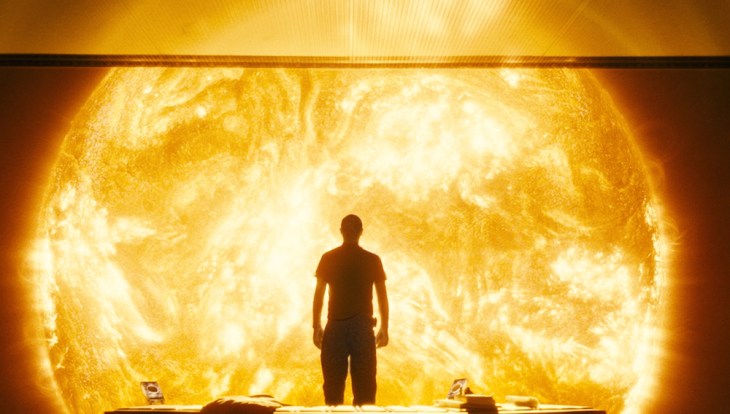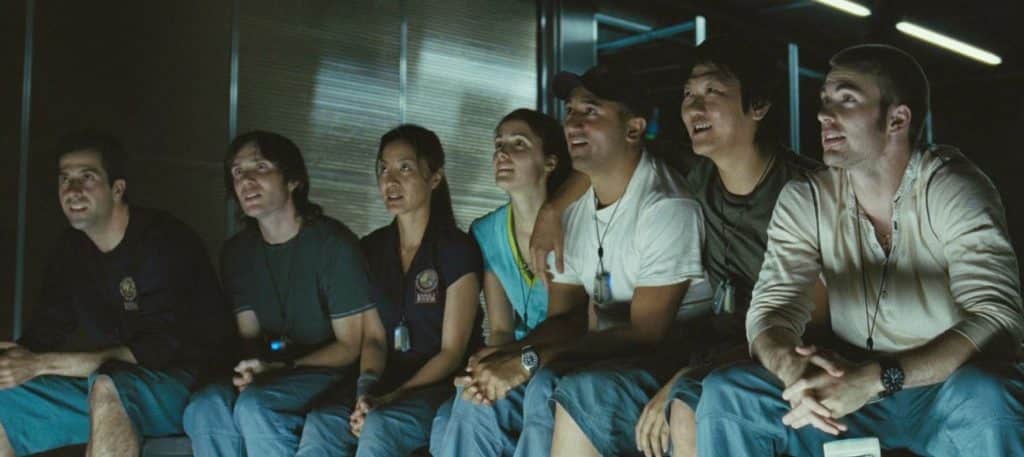
Sunshine (2007) directed by Danny Boyle and adapted from Alex Garland's screenplay is provocative, beautiful, and sad.
Quick Plot Review
In the ship Icarus II, a team of spacers is en route to what is most likely a one-way trip to launch some nukes into the sun to give its flagging nuclear chain reaction a jumpstart. This mission marks the second attempt to drop nukes into the sun--and I'm not talking about Superman IV. Icarus I was a wash after its captain--Pinbacker--loses his head, kills his crew, gets his skin burnt off, and goes on an endless rant about talking to God. Pinbacker has somehow survived on Icarus I even though he's been exposed to thousands of degrees of heat. When the two Icarus ships are linked, Pinbacker somehow gets aboard and runs his tricks on Icarus II.Ultimately, the crew of Icarus II recover control of the ship from Pinbacker, get close enough to the sun to release their payload, they are irrevocably destroyed, and the sun starts shining at full power once again.
Sunshine's Narrative Problems
One problem with the movie is that the sun has no shortage of fuel for its nuclear chain reaction. The star at the center of our solar system is in its middle age. With a life span of nearly 10 billion years, it is 4.6 billion years old. We're good for another 5 billion. Stars are a constant, reliable, long term source of energy. This movie should have taken place in the far-flung future, with an Earth almost completely abandoned except for a cult of the dying sun that attacks scientists for attempting to alter what God has set in motion. And the mission should have been taken on by expendable but tremendously advanced androids. Of course, had too much logic been applied to the screenplay, you'd lose all pathos. Who wants to watch a movie about robots programmed to shoot a nuclear weapon at the sun?Another problem with the movie is that even if the sun was having some sort of problem with its chain reaction, kicking in one nuclear device the size of the Truman Show dome would hardly make the slightest difference in the sun's nuclear reaction. The diameter of the sun is 864,340 miles. For perspective, the diameter of the earth is 7,917.5 miles. The sun burns at 27 million degrees Fahrenheit. Dropping in the payload of one nuclear weapon would be akin to adding one drop of boiling water to the world's oceans in an effort to raise the water temperature. The weapon, like the drop, is insignificant.
Robert Heinlein and Science Fiction Theory
The ability to identify with the struggle of and achievements of humans is a major draw of literature--even science fiction literature. Robert Heinlein maintained that science fiction must contain two elements:- novums - newly developed technology or advancements in science, including biology, chemistry, genetics, psychology, physiology, etc.
- human condition - including the response that humans have to changes in technology and scientific advancements. This typically explores how human life is simplified, made more complicated, or, funny enough, doesn't change despite a changed world. All of these human responses are within the spectrum of possibility.
The Cult of Youth

The plot of Sunshine fits into a longstanding literary tradition of sacrificing beautiful and intelligent young people for the greater good of society. Examples include Jesus Christ and Romeo and Juliet. The title from a 2000 version of Romeo and Juliet was called Romeo Must Die, an incredibly apt title for this theme--that sometimes great sacrifice is required to elicit required change in society. The death of a young person places an even greater emphasis on sacrifice. A young person has more life to lose by dying than someone older. And life is precious. We grieve its loss. With youth comes beauty. The passing of youth and beauty always reads as tragic.
Evolution, Society, and Sacrifice
The idea of the necessity of the sacrifice goes back to prehistory--the time before written history. Proto man would have had good reason to see sacrifice as important. In an age when humans were hunter-gatherers, death was an even more present aspect of life. To survive, tribes of men regularly had to kill animals, sacrificing the life of the animal for their own. Also, in defending the tribe--whether against hostile tribes or beasts, sacrifice was often required. And women, without modern healthcare, sacrificed their bodies, and often their lives, to give birth to the next generation. Sacrifice was a way forward. Since humans have possessed a fairly consistent intelligence for the last 40,000 years, they had plenty of time to consider the meaning of life, of the cycle of life and death and the meaning of sacrifice.Sunshine considers an age-old story--the sacrifice of a few strong men and women for the greater good--and launches it into space with a mega sun shield and an equally massive nuclear weapon. Even with all of its faults though, the sacrifice narrative is easy to connect with. In the 21st century, we don't like to think about death too often, but it's never all that far from our conscious awareness of self. We know that we must die. We know too that our life will stand for something. Watching a story of men and women that sacrifice themselves resonates deeply, reminding us of the generations before us that sacrificed so that we might have life. It reminds us as well of the sacrifice we are called to make for the generations to come.
Ready for more Rapid Transmissions?
Nancy Kress’s Terran Tomorrow